
views
- Wrap a strip of paper or piece of string around your chosen finger, mark where it overlaps, unwrap it, and measure its length along a ruler or tape measure.
- Place an existing ring over a circular ring sizing chart or use a ring sizer to determine your size.
- To find someone’s ring size secretly, measure their other rings, ask their friends or family, or choose a larger ring size and resize it later.
Using a Piece of Paper or String
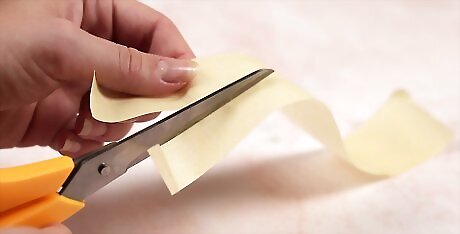
Cut a thin piece of paper or string about 6 inches 6 in (15 cm) long. If you're using paper, aim for a width of about ⁄2 in (1.3 cm) or so. These measurements don't have to be exact, so feel free to eyeball it. If you’re using paper, you can trim your strip to the thickness of your desired band to see what it would look like around your finger.

Wrap the paper or string around your finger and mark where it meets one end. Wrap it around the base of the finger you want the ring to be sized to. The string or strip of paper should be tight enough not to slip over your knuckle but loose enough to be comfortable. With the paper wrapped around your finger, mark on the side where the strip overlaps with the end of the paper. String or floss can stretch out easily, so make sure not to pull them too tightly around your finger.

Measure the string or paper and compare it to a ring sizing chart. Unwrap the strip or string and stretch it along a ruler or measuring tape. Write down the length from one end to your mark to get the circumference of the ring. Look at an international ring size chart and follow the closest circumference along the chart to the associated ring size. To get the diameter, divide the length of the string or paper by 3.14 (or π). If your ring size is slightly different from the ones on the chart, go with the larger size.
Using a Tape Measure
Wrap a flexible measuring tape around your finger. Choose a cloth measuring tape for an accurate measurement. Wrap the tape close to the knuckle so that your ring will be able to slide over it comfortably. Use the exact finger that will wear the ring. Even the same finger on the other hand may be different sizes—your left hand might be larger or smaller than your right hand depending on which hand is dominant. The size of your fingers tends to change throughout the day. Weird, right? For best results, measure at the end of the day.
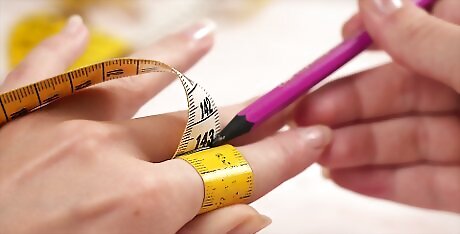
Record the measurement where the tape overlaps. Note where the end of the measuring tape overlaps on your finger. On a separate piece of paper, write down the measurement in millimeters to get the circumference of your ring size. To find the diameter of your ring size, divide the circumference by 3.14 (or π).
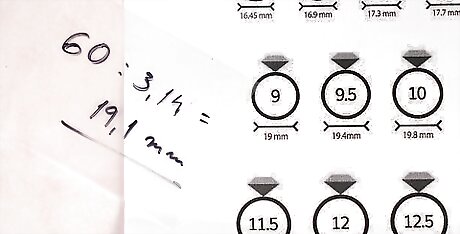
Compare the measurement to a sizing chart. Now that you’ve got the numbers, it’s time to find your size. These charts convert measurements into ring sizes—for instance, 59.5 mm would be a size 9. If your measurement falls between two sizes, choose the larger size.
Using a Circular Ring Sizing Chart

Print out a circular ring sizing chart if you have an existing ring. A circular ring sizing chart shows a number of circles of different sizes that you can use to measure a ring you already have. To make sure that your chart is accurate, scale the PDF to 100% before you print and ensure that any automatic scaling options are turned off. For even better accuracy, look at a sizing chart from the retailer you want to purchase your ring from. That way, you’ll know the sizing on the chart will match the sizing of their products.
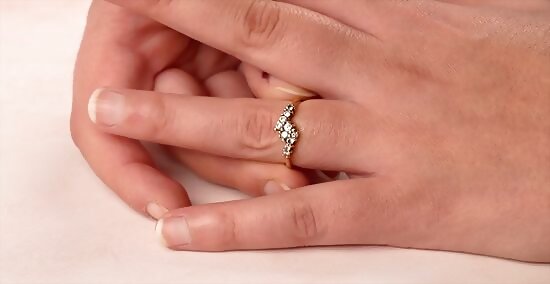
Find a ring you own that fits the finger you’re trying to size. Choose a ring that doesn’t slide off over your knuckle but won’t leave an indent on your finger when removed. Make sure the ring fits the finger on the correct hand—even your two ring fingers can be different sizes!
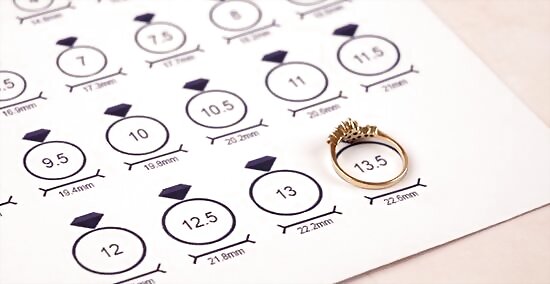
Place your ring over the circles on the chart. Place a ring that you or a loved one already wears on top of each circle until one fits perfectly along the inside of the ring’s band. If you’re stuck between two close sizes, choose the larger size—your fingers naturally swell throughout the day, so this may prevent the ring from being too tight later.
Using a Ring Sizer
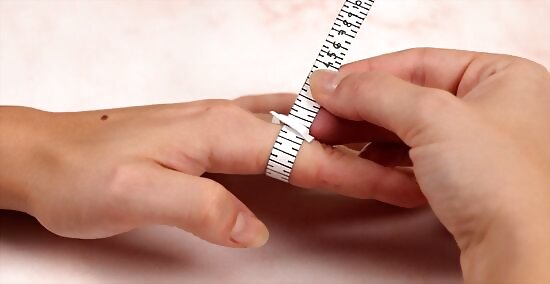
Use a printable ring sizing tool. Print and cut out a paper ring sizer using a pair of scissors. Cut along the line inside of the tool that says “Cut slit.” Slip the pointed end of the sizer through the slit and wrap the sizer around your chosen finger with the printed side out. Gently pull on the pointed end of the sizer to a comfortable, snug fit. Lay the pointed end against the paper to see what measurement the arrow points to. When printing, make sure that the PDF is printed at 100% and that all auto-scaling options are turned off. To make sure that your ring size is accurate, ask someone to help you measure. Measure a couple of times throughout the day to ensure that your ring size is accurate.

Use a plastic measuring ring sizer tool. You can order a plastic ring sizer to find your ring size. The best part is that it’s reusable and can be used on any of your fingers. Wrap the plastic tool around your chosen finger, thread the pointed end into the loop, then pull until you get a snug comfortable fit. The arrow on the loop will point to your ring size. If the arrow doesn’t point to an exact size (like 7 or 7 ½), round your measurement to the nearest larger half or whole number.

Use a stainless steel ring sizer. A stainless steel measuring ring tool looks like a keyring with multiple steel rings hooked onto it. Starting with the largest size, slip each ring onto your chosen finger until you find one that sits snugly on your finger but doesn’t leave an indent when you remove it. Your ring size is engraved into the end of the ring that hooks to the loop.

Use a ring mandrel to measure a ring you already have. A ring mandrel is typically used for stretching or forming rings, however, they can also be handy for figuring out your ring size. If you have a ring that already fits well to your chosen finger, slide it over the smaller end of the mandrel and note what size it settles at.
Secretly Finding Someone Else’s Ring Size
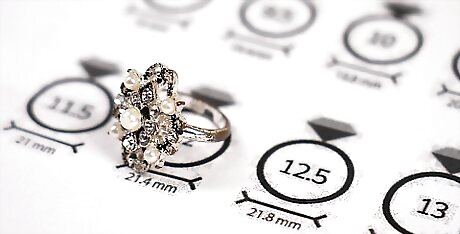
Measure a ring that you've seen them wearing before. If you’re looking to get a ring for your loved one and they already have a ring that fits that specific finger, you can use a circular ring sizing chart or a ring mandrel to find the sizing. You can also take the ring to a jeweler when you’re picking out the ring—they may be able to size the ring for you more accurately. For an engagement ring, make sure you measure a ring that fits their left ring finger.
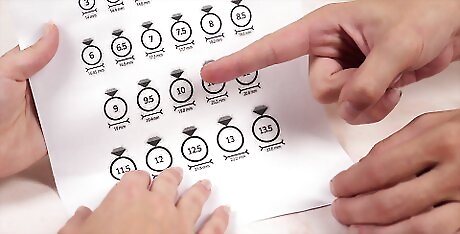
Ask their friends or family members if they know the size. A close friend or family member of your loved one might already know their ring size. Even if they don’t know right away, you might be able to team up so they can sneakily ask that special someone their ring size and get the answer for you. If you have a friend or family member with a similar hand size, you can ask them to try on rings and buy one that’s a similar size. However, this method isn’t as accurate as measuring their exact finger.
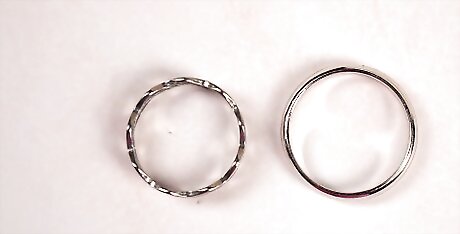
Opt for a larger size and get the ring resized later. If you can’t find another way to sneakily get that special someone’s ring size, you can always take the ring to the jeweler and get it resized later—aim for a ring size above average so you can size down. The average ring size for women is US 5 to 7 (UK J to N, EU 50 to 55), and US 10 to 11 (UK T to V, EU 62 to 65) for men.


















Comments
0 comment